Nokia Lumia 830 Review
by Brett Howse on November 25, 2014 8:00 AM EST- Posted in
- Smartphones
- Microsoft
- Lumia
Display
Features such as two-stage camera buttons, multiple microphones for noise cancellation and surround sound video recording, and LTE connectivity are all great, but the one thing you use on any smartphone the most is the display. This means that a good display is something that all manufacturers should focus on. The improvements to smartphone displays over the last several years have been pretty dramatic, but it is still one area where a phones with similar internals can differentiate themselves from the competition.
The Lumia 830 has a five inch 1280x720 resolution IPS LCD. The Lumia line has alternated between Organic LED displays and Liquid Crystal Displays for many of their models. This particular device did end up with a LCD though, which brings the strengths and weaknesses of LCD along with it. Generally, color reproduction is better on a LCD but black levels and contrast cannot match OLED displays, with only the most recent Samsung OLED panels bucking that trend. The resolution of the Lumia 830 is a bit off the 1080p displays we see on higher end phones, but at 294 pixels per inch it is reasonably sharp and falls just under the iPhone 6 and its 326 pixels per inch.
As you can see in the above image, another advantage of LCD is that they are generally a RGB stripe, so there are no extra pixels or pentile matrices to deal with.
As with the Lumia 930, the Lumia 830 also supports “sunlight readability enhancements” which is a method of doing per pixel based content-adaptive backlight control from Apical which helps the perceived image when the device is used outdoors. The brightness is much higher on the 830 than the 930, but these additions can make the device much more usable outdoors.
One of the issues I had with the Lumia 630 when I reviewed it was the display had an almost matte texture to it which caused your finger to catch and drag when using the touchscreen. The Lumia 830’s ClearBlack display suffers none of this, and has a wonderful smooth coating on it which is also easy to clean. One other feature that seems to be somewhat exclusive to Lumia phones is Super Sensitive touch which allows the device to be used with gloves on and still interact with the touch screen. As you will see in the upcoming camera section, this is appreciated in colder climates.
To test the display accuracy, we turn to Spectralcal’s CalMAN 5 software package with a custom workflow. We utilize the X-Rite i1Pro Spectrophotometer for color accuracy and saturation, and the X-Rite i1Display Pro for contrast ratios.

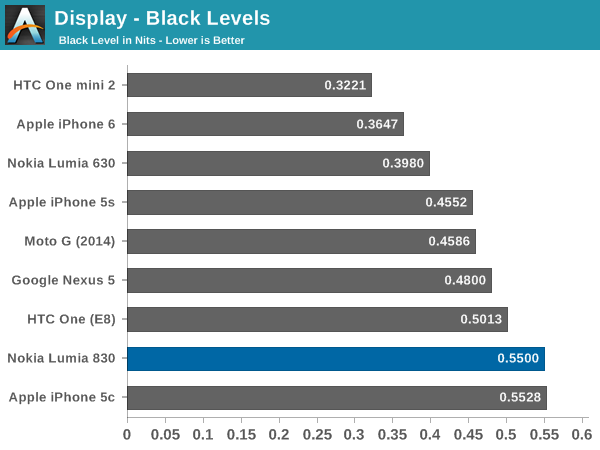
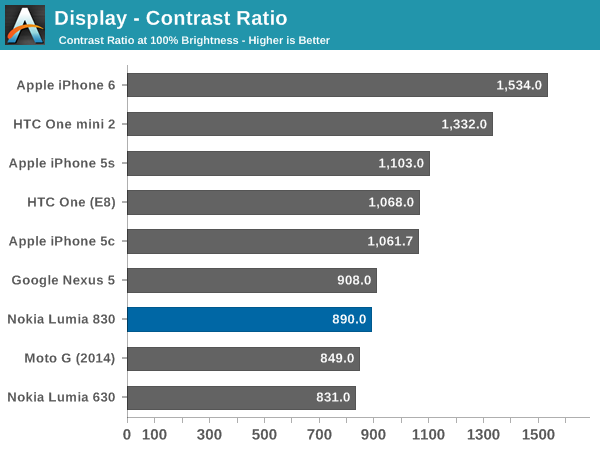
At almost 500 nits, the Lumia 830 is plenty bright for most situations. However the relatively poor black levels result in a contrast ratio that is not spectacular. The black levels are the one thing I noticed while using this device especially when my daily phone is OLED.
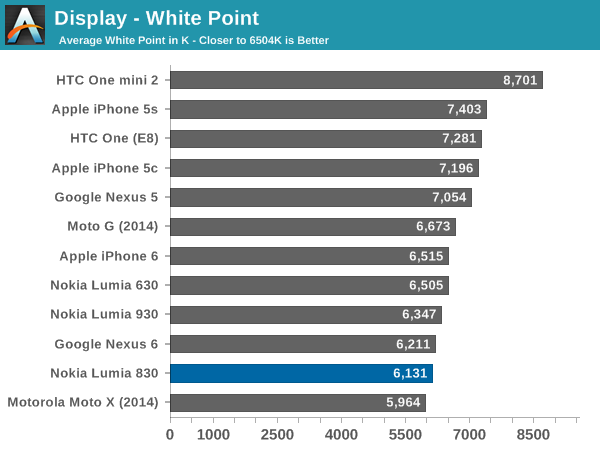

The white point on the Lumia 830 is a bit under what we would be looking for, however you can see from the Calman results that the green starts to shift quite high as the white level rises. That combined with the blue falling away results in a less than amazing 5.207 grayscale average dE2000 score. It is not a great result especially when compared to the Lumia 630, which was one of the better scoring phone displays we have tested and is in a much cheaper device from the same manufacturer. It is clear that the Lumia line has not yet taken display calibration seriously.
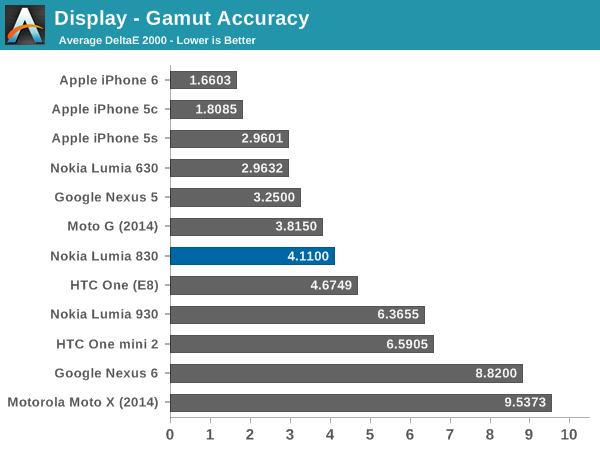
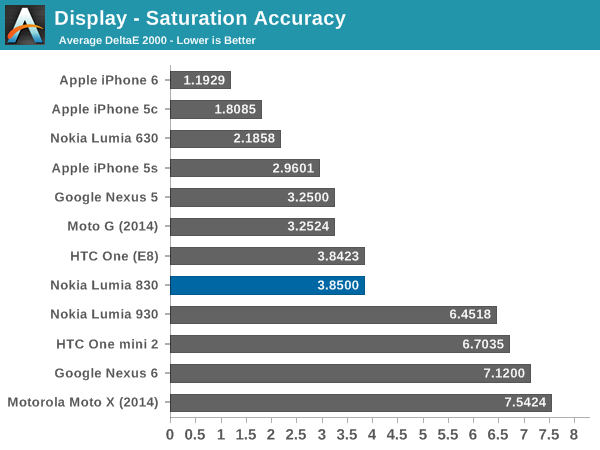
The saturation sweeps are a bit better than grayscale. We are looking for values under 3, and the Lumia 830 is not too far off this mark. At 3.85, it is still quite a way from the Lumia 630’s 2.18 though.
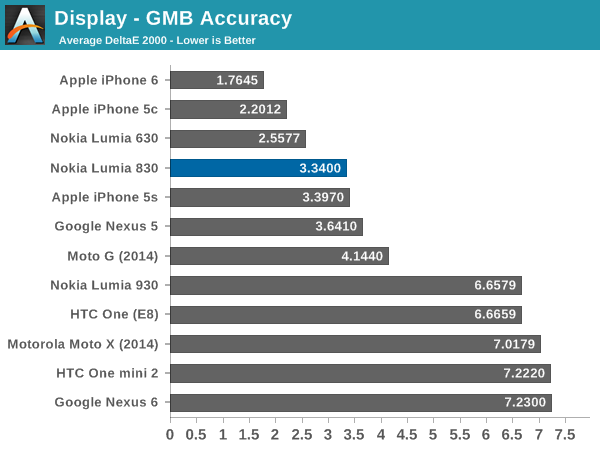
The Lumia 830 does fairly well in the GMB checker, despite the poor grayscale. It comes in with a good, but not great result, and still falls short of the Lumia 630.
The Lumia 830 does support the recently added options for an advanced color profile, which will allow a user to adjust the display to one of three presets (Standard, Vivid, Cool) or to choose Advanced and manually adjust color temperature, tint, and saturation. We are still without a mobile operating system with full color profile support, but this is a good step in the right direction.
Using these settings, you should be able to pull the green down a bit in order to correct the display. The disappointment is that the display is not correct when it leaves the factory though.
The Lumia 830 ends up with a middle of the road LCD. Black levels are not the greatest, but the overall accuracy of the display is not so far off the charts as to be unusable either. The white point is a bit low, but better than some displays which come from the factor with a huge blue shift.


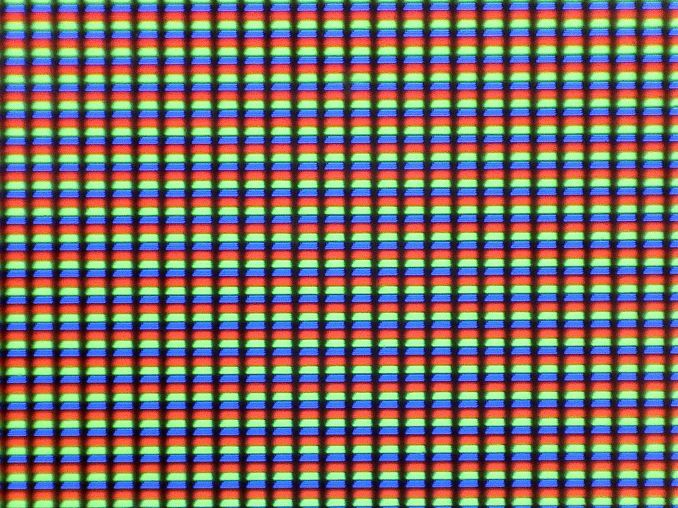



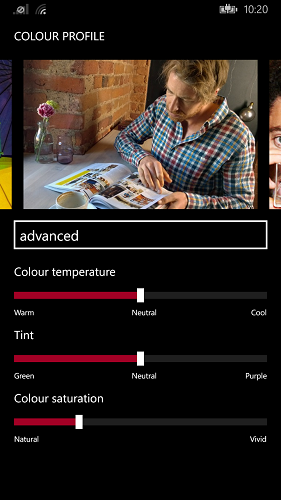








98 Comments
View All Comments
cheshirster - Saturday, November 29, 2014 - link
Yes. S800 is the only candidate and it is to pricey for the segment whrere 830 is going to play.And S800 with 2200mah battery... Don't think it would be a good deal?
cheshirster - Saturday, November 29, 2014 - link
Why no cyanogen? O P O comment section pretty covers it.http://www.anandtech.com/comments/8242/the-oneplus...
StrangerGuy - Tuesday, November 25, 2014 - link
$400? Even at *mere* $200 that must be some really strong crack Nokia is smoking in a market filled with non-contract $180 Moto Gs and $150 Redmi Notes.cheshirster - Friday, November 28, 2014 - link
Keep calm and bing galaxy A3 prices.tuxRoller - Tuesday, November 25, 2014 - link
Is that Nexus 9 article still happening, or was the preview really the review?Laxaa - Wednesday, November 26, 2014 - link
It's great to see that WinPhone finally is getting the attention it deserves on this site! Keep up the good work.As for the device, it's one of those "this one had potential". I am disappointed by the lack of a true holiday flagship to replace my 920(which still works fine, btw) and it's kind of worrysome that there won't be one coming out anythime soon. The 830 has a lot of features that I want(slim design, better audio capture, SD-card support) but the SOC just doesn't cut it for me. If it was a notch faster, I would have jumped and used it as a stop-gap phone for the next couple of years.
(The 930 is not interessting to me because ot the mediocre battery life and the low internal storage)
Klimax - Wednesday, November 26, 2014 - link
Good review and quite matches my experience.I'd have small suggestion: Game "Total Defense" could be used as general gauge how well 3D games will work on WP8.x and W8.x devices. Although it doesn't have FPS meter, it is very visible if game doesn't run fast enough including touch input. (+ main menu itself can provide hint how it will work)
Myrandex - Thursday, November 27, 2014 - link
The 10MP Pureview camera isn't the smallest pureview camera. The Lumia 920's 8.7MP camera was the first Nokia Pureview windows phone camera and honestly I have been impressed by that camera many times. So people commenting about how this 10MP doesn't deserve the name I feel doesn't know what they are talking about, as that 8.7MP one has taken numerous nice shots in multiple shooting conditions for me.kspirit - Friday, November 28, 2014 - link
I believe they were talking about the sensor size, which is far more important. Not the raw MP count.Laxaa - Friday, November 28, 2014 - link
They were. The 920 sensor is also larger than the 830 sensor(1/3.2" vs 1/3.4")